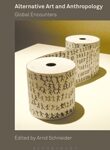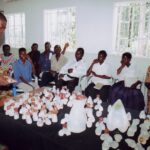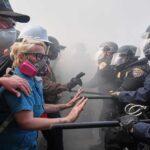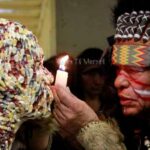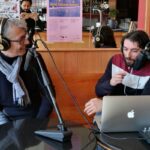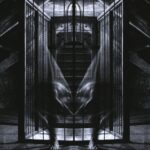Book Review: Angela Harutyunyan, The Political Aesthetics of the Armenian Avant-Garde: The Journey of the ‘Painterly Real,’ 1987–2004, (Manchester: Manchester University Press, 2017)
Marianna Hovhannisyan
Introduction
The Political Aesthetics of the Armenian Avant-Garde: The Journey of the ‘Painterly Real,’ 1987–2004 is by Angela Harutyunyan, art historian and associate professor in the Department of Fine Arts and Art History at the American University of Beirut. The book introduces Harutyunyan’s ongoing contribution to the body of work in art history and criticism which aims to historicize the advent of contemporary art in Armenia after the collapse of the Soviet Union in 1991.[1] Based on her decade-long archival research and fieldwork, this is the first English-language attempt at a cohesive art historical account of Armenian contemporary art. Methodologically, Harutyunyan has taken on an ambitious task: “to eject the subjectivity of the author from the historical narration, to un-remember a decade formative for my [her] generation, in order to re-remember it as history.”[2]
Two Parallel Transitions
The author focuses on the development of alternative artistic practices during two transitional periods: the late-Soviet, perestroika years before the collapse of the Soviet Union that lead to the independence of Armenia in 1991; and the post-Soviet Armenia, from the 1991 independence to the early 2000s. Her overall conceptual framework interweaves the many issues pertaining to the emerging liberal democratic public sphere and cultural politics of Armenia, which in turn brought forth controversial artistic reflections on the ideals of absolute freedom and of aesthetics.[3] In the context of the late-Soviet 1980s and post-Soviet 1990s, this approach allows the reader to discover that the articulation of contemporary art in Armenia is firmly connected with a rethinking of the avant-garde as the autonomy of art. The author explains, the advent of contemporary art was envisioned as a realm, which was “the ideal of a world without borders and boundaries.”[4] This is an interesting observation in terms of the geopolitical location of Armenia, too. It is a country whose borders are closed with Turkey,[5] as well as contested with Azerbaijan, another former Soviet Republic. The border issue with Azerbaijan is conditioned by the war which erupted during the perestroika period by returning to the unresolved ethno-territorial conflicts between Armenia and Azerbaijan over the Nagorno-Karabakh Autonomous Oblast in 1988.[6]
Within such layered sociopolitical and cultural entanglements, Harutyunyan states that the emergence of contemporary art in the 1980s and 1990s was not regarded as “neo-avant-garde” or “post-” as in the examples of post-socialist Eastern Europe. It was approached by the artists as a realm of art’s autonomy—the avant-garde, the alternative, critical, and future-oriented liberating practice: “[it] saw itself as the vanguard of progressive time, wherein art moves time ahead, into the future, even if this future was one of market economy and liberal democracy.”[7]
Painterly Real
Harutyunyan constantly returns to two dominant historical crises that emerged as unresolved issues in the post-Soviet condition of Armenia. The first refers to the quest for a nation state that had been interrupted by the early (1920s) Bolshevik program in the Soviet Republics, which sought to repress ethnic and nationalistic identities that would hinder the final victory of international communism. The second crises can be described as “the failure” of the revolutionary agenda of the historical artistic avant-garde in the socialist countries.[8] Both crises inform her main focus on the nature of artistic practices of the late 1980s, mid-1990s and early 2000s that oscillate between gestures of the negation and affirmation of the social and political spheres.
It is at this point that Harutyunyan proposes a new term: the “painterly real.” At first glance, the term seems to refer to the understanding of “New Painterly Realism” coined by Kazimir Malevich, the pioneer of the Russian avant-garde. According to Malevich, both color and texture are the essence of painting, and the preeminent values in painterly creation, i.e. the art should have the capacity to transcend the subject matter (over image and narration). As Malevich writes, the painterly creation “has always been killed by subject,”[9] such as, one might note, in the case of realist painting with the recognizable subjects. In contrast, one of the central claims of Harutyunyan about the “painterly real” is that the contemporary art in Armenia can be traced and analyzed through the confrontations that unfold out of the return of a multilayered subject. It is the bourgeoisie subject, which had been repressed in the beginning of the century by these above-mentioned two crises—avant-garde and Bolshevism. At the same time, it is the Armenian subject, so to say, with the peculiar construction and history of national identity. More importantly, it is the artist-subject whose subjectivity and actualization were seemingly deferred and suppressed by the Soviet ideology. In the context of late-Soviet and post-Soviet Armenia, Harutyunyan’s “painterly real” allows artists to engage the search for art’s autonomy in the realm of an “everyday life” that stands in for the experiential reality. In this sense, art’s autonomy becomes a domain “more real than reality itself,” a search of the ontological exploration of the artistic self through displacement, where art itself becomes the ideal.[10]
Harutyunyan writes that the “painterly real” is the historical logic connecting Armenian contemporary art to both Soviet official art (Socialist Realism) and the Armenian Modernism of the 1960s and 1970s. The Armenian Modernist artists refused the official art by working with both the discourse of national and modern. To explain this, she utilizes the concept of “National Modernism” from art historian Vardan Azatyan. The modernist negation of a reified tradition of Socialist Realism in Armenia occurs through the search for new colors, forms, and subjects for painting. One aspect of the discourse of “National Modernism” can be understood as marking a return of visual references often from the Medieval as the historical Armenian/national culture. The other aspect concerns the significance of working with abstraction that played a critical role in the 1960s artistic development in Armenia due, in part, to the legacy of the Abstract-Expressionist painter Arshile Gorky, who was of Armenian origin. Those artists would also be the group who was related with the opening of Yerevan’s Modern Art Museum in 1972 founded by art historian Henrik Igityan. It was a unique precedence in the whole socialist bloc. Harutyunyan writes that until now this specific museum is perceived for contemporary art. Thus, the modernist gesture of negation of reified tradition was staged against the existing Soviet system, and manifested by championing the autonomy of artistic forms rooted in national content.[11] This also emerges at the margins of redefinitions of what could be called “modern” or contemporary art in the 1960s and 1970s Soviet Armenia.
Case Studies: The 3rd Floor Movement
As foundational case studies for her book, Harutyunyan discusses two artistic formations in Yerevan—the 3rd Floor cultural movement (1987–94) and the ACT Group (mid-1990s). Several dozen artists, musicians, art critics, and writers were part of the 3rd Floor movement throughout the period of its existence. In contrast, the ACT Group was more of an enclosed group of friends constituted through a coherent artistic and ideological agenda. She proposes that the 3rd Floor was “the cultural vanguard of a liberal democracy yet to be instituted”[12] in the late-1980s social and political transformations. This occurs in the context of the last General Secretary of the Communist Party of the Soviet Union, Mikhail Gorbachev, and his call for so-called openness or transparency of the Soviet system, i.e. glasnost (1986–89), and for reconstruction, i.e. perestroika (1984–91). In terms of ACT Group, Harutyunyan suggests looking at how its practices demonstrated what was at stake around the state cultural politics of imagining and instituting infrastructures of independent, democratic Armenia in the mid-1990s.

The 3rd Floor represented the “painterly real” as a negation of the ideology of Socialist Realism “through a supposedly non-ideological form of freedom, and of official painting through the painterly gesture.”[17] At the same time, the members of the movement also had a conflicted relationship with Armenia’s “National Modernism.”[18] As Harutyunyan’s research presents, by attacking the Artists’ Union, the movement’s main medium becomes the exhibition itself, and their future practices would dominantly be exhibition-events. The author accurately observes: “If for National Modernism the medium for liberation was paint gesturally applied on the canvas, for the 3rd Floor the medium-specificity of painting is dissolved as the gestural act is extended to the exhibition conceived as a space for freedom.”[19] Here, it becomes evident that her notion of the “painterly real” is not about the painting, but rather, it is about the very medium of gestures of negations or exhibition-making and exhibition-space themselves as medium for the intervention. In the case of confronting the official art, the 3rd Floor readapts the painting not as a surface for the national/abstract content, but as a privileged vehicle for avant-garde art. However, by doing so, as the author claims, the movement unwittingly reproduces it in its perception of art as a “sphere of subjective liberation.” [20] Interestingly, this is a liberation of a multilayered subject, here more an individual as bourgeoisie one. The artistic practice secures art as the ideal for the liberation which was supposedly happening in the perestroika context as a social dream for freedom. What follows in terms of issues of independence would be approached by the mid-1990s case study—the ACT Group.
ACT Group
Another key chapter is devoted to the second case study, the ACT Group. Harutyunyan proposes to examine the group as the over-identification of conceptual art practices with the procedures of liberal democracy advocated by the first President of the Republic of Armenia, Levon Ter-Petrosyan in the mid-1990s. In this sense, ACT’s understanding of the autonomy of art matched with the dynamics of an ongoing inception of a state apparatus in an independent country, where the imagined democracy implied the autonomy and freedom of individual Armenian citizen. In such an indeterminate phase, the idea of an artist’s direct, oppositional confrontation is ineffective. On the contrary, it can be inferred that the ideals for autonomy imagined both for a civic state and art had the opportunity to emerge parallel into practical existence.

Such democratically imagined ideals were equally valid projections, both for the first president Ter-Petrosyan and for this particular group of artists. However, as the further development of the country will show, both of them “constituted the state in thought rather than objectively.”[27] This can be explained in the following way. The group emerged in “the crisis of negation.”[28] Soviet Union as the dominant target of artistic avant-garde negation in Armenia and in general, for other former Soviet countries, is just gone. ACT’s tactics were also affirmative in this sense, for instance, compared to the 3rd Floor’s, whose ideals for the art’s autonomy was manifested in the resistance against the Soviet art infrastructures. Harutyunyan discusses how the ACT saw art’s autonomy within a paradigm art for art’s sake, which somehow was an escape from the impossibilities of the turbulent reality. After the collapse of the Soviet Union, the mid-1990s were one of the most controversial periods that would complicate both the discussion about the democratic with the national. The transition of the political power from the Soviet to the independent republic, as the author highlights, took place in the conditions when the former semi-official intelligentsia of the ex-Soviet Armenian Socialist Republic were now serving as Armenian bureaucrats and state official proposing their visions for this independent state.[29] The rapid privatization as well as redefinition of Armenian national identity, the devolution of currency, the impossibilities to form a liberal market, the Nagorno-Karabakh conflict, or the former participants of the war also getting involved in the construction of the country would be markers of these complications. Therefore, her last chapters examine the return of “painterly real” as somehow the dominant and the only mode of historization in contemporary Armenian art of the early 2000s.[30] Harutyunyan traces the subsequent careers of ACT Group members such as David Kareyan and Narek Avetisyan, and Arman Grigoryan from the 3rd Floor, to discuss their return to the medium of painting through media art and performances during the 2000s in the context of the development of a tech-based economy in Armenia. It can be said that the return of “painterly real” is the impossible actualization of a subject in the neoliberal condition in Armenia. This condition embodies the new (oligarchic) authority of official national policies and its unfilled promise of liberal democracy.
Hartunyan’s work is a unique, well-researched thesis within a complex art historical domain shared and mapped out by several disciplines. It offers a solid methodological contribution to the historiography of contemporary art, through a multilayered approach able to analyze fragmented transitional time-periods whose effects are still being played out in the current Armenian art. It offers hard to find crucial artworks, debates, and exhibitions from the Armenian 1980s and 1990s context. There are many useful insights to those interested in late-Soviet and early post-Soviet artistic practices as an art historical field of studies, both for research and teaching purposes. For example, she analyzes an almost forgotten Soviet philosophical debate on ideals of art, autonomy, and alienation which took place in the late 1970s and the first part of the 1980s between a Marxist author and Soviet philosopher, Evald Ilyenkov and a Soviet Marxian literary critic and philosopher of art, Mikhail Lifshitz.[31] In addition, there is certain theoretical knowledge shared with readers about post-Soviet art discourse on post-socialist Eastern European contemporary art practices. In the multidisciplinary field of art history and criticism, The Political Aesthetics of the Armenian Avant-Garde: The Journey of the ‘Painterly Real,’ 1987–2004 places new emphasis on rethinking the socialist past through the lens of aesthetic theory. Importantly, this goes beyond the normalized perception of the Soviet or post-Soviet critical art that is constructed dominantly through hegemonic narrative of the Russian avant-garde, Sots art, and nonconformist art. Harutyunyan’s book offers to recognize the varied distinctions, such as geopolitics, culture discourses, and identity politics, have to be drawn when working with the Soviet past and post-Soviet present in avant-garde artistic practices.
Special thanks to the editorial team of FIELD, as well as to Angela Harutyunyan for providing the images.
Marianna Hovhannisyan is a PhD Candidate in Art History, Theory and Criticism (Art History Concentration) at the University of California, San Diego.
Notes
[1] For example, Public Spheres After Socialism, a volume co-edited by Harutyunyan. The full reference to the book is Angela Harutyunyan, Kathrin Hörschelmann and Malcolm Miles, ed. Public Spheres After Socialism (Intellect Ltd, 2009).
[2] Angela Harutyunyan, The Political Aesthetics of the Armenian Avant-Garde: The Journey of the ‘Painterly Real’, 1987–2004 (Manchester: Manchester University Press, 2017), 10.
[3] Ibid., 1–2. The following quote might be helpful: “This historical study aims at outlining the politics (liberal democracy), aesthetics (autonomous art secured by the gesture of the individual artist) and ethics (ideals of absolute freedom and radical individualism) of contemporary art in Armenia in post-Soviet conditions from a critical perspective and in ways that point towards the limitations of the aesthetic and political horizons of contemporary art in the post-socialist context.”
[4] Ibid., 29.
[5] The border issues of the Armenia-Turkey diplomatic relationship represent a historical condition. This relationship is one of the central crises in the region, because of the Armenian Genocide in 1915 committed towards the Armenian native communities during the Ottoman Empire and still officially denied by Turkey. The border between Armenia and Turkey was closed in 1993. As Turkey supports Azerbaijan against Armenia in relation to the Nagorno-Karabakh War, the border issue would gain an additional meaning.
[6] The Artsakh/Nagorno-Karabakh War (1988–94) was one of the first armed conflicts in the former Soviet Union between Armenia and Azerbaijan. Artsakh is an integral part of historic Armenia. As the official website of the Ministry of Foreign Affairs of the Republic of Armenia indicates, the conflict began in 1917, when the population of Nagorno-Karabakh, 95 percent of which were Armenians, proclaimed Nagorno-Karabakh as an independent political unit. However, this was repressed. In 1922 Azerbaijani and Armenian SSR were included in the formation processes of the Soviet Union, and in 1923, on the territory of Karabakh, the Nagorno-Karabakh Autonomous Oblast was formed, but within Azerbaijan SSR. That was done by the direct support from the Soviet Union. The territorial belonging was the core of the war which erupted in 1988 with the claims for the return of the historic lands from the Armenian side. According to 1989 statistics the number of Armenians was 76,9 percent. So-called a peaceful resolution of the Armenian-Azerbaijani dispute took place in 1994. Now, it has been largely controlled by the self-proclaimed Republic of Artsakh, which is a de facto independent entity and dominantly populated by Armenians. However, until now, it stays one of the dangerous and “frozen” geopolitical conflicts in the former-Soviet space and for Caucasus region.
[7] Ibid., 29. Harutyunyan compares this with the concept of “post-utopian art” by Boris Groys. Please note that “art’s autonomy” is the application by the author.
[8] The author means the general history of avant-garde in the Soviet Union and how it was oppressed in the mid-1930s by Joseph Stalin with the inception of the official art. As an example of the Armenian avant-garde, Harutyunyan refers to biweekly newspaper Avant-garde which was part of the Soviet Armenian All-Union Leninist Young Communist League. See page 30.
[9] Kazimir Malevich, “From Cubism and Futurism to Suprematism: The New Realism in Painting,” (1915) in Russian Art of the Avant-Garde Theory and Criticism 1902–1934, ed. and trans. John E. Bowlt (New York: The Viking Press, 1976), 116–135.
[10] Harutyunyan, 2, 80, 106, 237.
[11] Ibid., 81. In general, the reference to the article about “National Modernism” is Vardan Azatyan, “National Modernism,” in Sweet Sixties: Specters and Spirits of a Parallel Avant-Garde, eds. Ruben Arevshatyan and Georg Schöllhammer (Berlin: Sternberg Press, 2014), 107–20. See also Harutyunyan’s second chapter called “The ‘painterly real’ of contemporary art: resurrected ghosts, living heroes and saintly saviours on the 3rd Floor, 1987-94.”
[12] Ibid., 89.
[13] Ibid., 59–61.
[14] Ibid., 52.
[15] Ibid., 46.
[16] Ibid. 66.
[17]Ibid., 12, or see Harutyunyan’s discussion about “the zero point of ideology filled in with gestures” on page 74.
[18] The majority of the Armenian alternative artists also “rejected” “National Modernism” as they found it timeless and full of lyrical connotations rather than charged with reflections on the actual reality.
[19] Ibid., 81.
[20] Ibid. Harutyunyan also draws the reader’s attention to the rarely referenced term hamasteghtsakan arvest meaning “collectively created” but individually realized art which was coined back then by two members of the 3rd Floor movement artist Arman Grigoryan and art historian Nazareth Karoyan. While both of them agreed upon on the term, they had different positions towards it. Their debate contributes to the discussion about the “painterly real” in relationship with “National Modernism,” “the national” and the perception of the autonomous art as avant-garde without boundaries. See pages 55–89.
[21] The exhibition was curated from the Armenian side by Susanna Gyulamiryan, Karen Andreassian and Samvel Baghdasaryan. While the title of the exhibition implies the loss of Soviet Union, it also had a biblical and mythical reading. In the Book of Genesis, after the great flood Noah’s Ark came to rest on the mountains of Ararat (historically in Armenian homeland, but now part of Turkey).
[22] Ibid., 149.
[23] Ibid., 13.
[24] Ibid., 147. For example, procedures like voting or imagining an artwork within free-market logic.
[25] Angela Harutyunyan, “Introduction to David Kareyan’s “Pure Creativity” and Hratch Armenakyan’s “Post-Art Situation: Logical Syntax”” ARTMargins 2:1 (2013): 120–126.
[26] Ibid., 146.
[27] Ibid., 172.
[28] Ibid., 13, 107.
[29] Ibid., 114.
[30] Ibid., 14.
[31] Ibid., 30–37.


